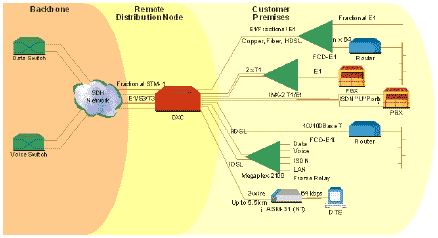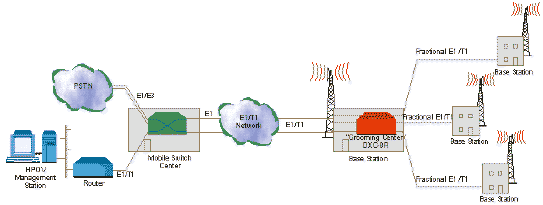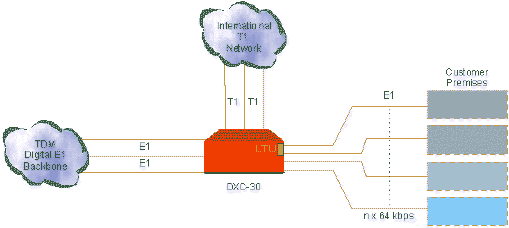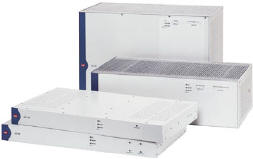FEATURES
-
Digital cross-connection for up
to 960 timeslots on copper, fiber or HDSL links
-
Supports Fractional STM-1, E3,
T3, E1, T1, n x 56/64, and ISDN services over copper (2/4-wire) and fiber
media
-
The modular DXC family includes
the following chassis types:
-
DXC-8R with 4 I/O modules
-
DXC-10A with 5 I/O modules
-
DXC-30 with 15 I/O modules
-
DXC-30E with 15 6U-high I/O
modules
-
Optional redundancy in common
logic and power supply
-
1:1 protective switching
-
E1/T1 conversion supports
A-law/?-law and signaling conversion
-
Transmission of T1 traffic over
E1, complying with ITU-T G.802
-
Traffic grooming into E3/T3
uplinks
-
Broadcast support
-
Inverse multiplexing module
supports up to 8 E1/T1 trunks
-
Controlled slip buffer for
overflow/underflow
-
TFTP support for common logic
software upgrade
-
Test and monitoring at any port
-
Management:
-
RADview SNMP management system
on UNIX (HPOV) platform
-
Telnet support
-
Separate dial-in/dial-out port
-
Supports SNMP agent and standard
management protocols: SLIP, PPP and RIP2
-
Local loop access solution with
LTU or CSU options for extended range, built-in fiber optic, or
2-wire/4-wire HDSL modems
DESCRIPTION
-
The DXC family of modular
Multiservice Access Nodes provides non-blocking cross connection of up to
960 timeslots for up to 120 fractional E1/T1 ports. Plug-in interface
modules provide n x 56/64 kbps, E1, T1, E3, T3 or Fractional STM-1
transmission over copper, fiber or HDSL. Also available is the DIM module
which provides inverse multiplexing capabilities of up to 8 x E1 or 8 x
T1.
-
Providing conversion/gateway
between E1 and T1 networks for both data and voice (see Figure 3).
-
Providing inverse multiplexing
of a single higher rate logical channel over up to 8 E1/T1 links (see
Figure 4).
CROSS CONNECT
-
DXC-30/30E supports up to 120
E1/Fractional E1, T1/Fractional T1, or up to 30 n x 56/64 kbps ports.
DXC-10A supports up to 40 ports, while the smaller DXC-8R supports up to
32 ports. A user-defined connection table programs connection of any
incoming 64 kbps timeslot to any outgoing 64 kbps timeslot. Support is
provided for drop & insert and broadcast applications.
E1/T1 CONVERTER
BASIC UNITS
-
The basic DXC-30 and DXC-30E
units include one power supply, one common logic module and fifteen
I/O slots for the plug-in interface modules. Optional redundancy for
the common logic and power supply is available.
-
The basic DXC-10A unit
includes one power supply, one common logic module and five I/O slots
for the additional plug-in interface modules.
-
The basic DXC-8R unit
includes two power supplies and two common logic modules for system
redundancy. DXC-8R has four I/O slots for the plug-in interface
modules.
-
Timing options cover for the
E1/T1 interface include internal clock, external station (master)
clock, and loopback timing from any selected E1/T1 or n x 56/64 kbps
port.
COMMON LOGIC
-
The DCL.2/DCL.3 common logic
module stores the matrix configuration and event information, as well
as configuration for alarm masking. It communicates with the
management station using a SLIP/PPP/Ethernet connection (by means of
an SNMP agent). DCL.2/DCL.3 can pass management information received
from 30 remote sites over a single dedicated timeslot or TS 0, to the
central management site. Flash for software download, Telnet and ASCII
terminal management are also supported.
I/O MODULES (see
enclosed data sheets for detailed specifications)
-
DT1B and DT1,
the two-port T1 interface modules, support both D4 or ESF framing
formats. For long range applications, a CSU option is available.
DT1B additionally provides BERT, loopback per timeslot, and 1:1
redundancy. DT1B is available with either copper or fiber optic
interface.
-
DE1B and DE1,
the two-port E1 interface modules, support both 2 and 16 frames per
multiframe formats, TS 0 multiframe with CRC-4 and HDB3 line code. For
long range applications, an LTU option is available. DE1B
additionally provides BERT, loopback per timeslot, and 1:1 redundancy.
DE1B is available with either copper or fiber optic interface.
-
DT3, the single-port
T3 interface module, supports multiplexing of up to 28 T1 channels
into a T3 frame with either C-bit parity or M13. DT3 is available with
either copper or fiber optic interface.
-
DT3/747, the
single-port T3 interface module (DCL.2 only) supports submultiplexing
of 21 E1s into a single DS3 data stream. Mixed (E1 and T1) traffic
applications are also available. The DT3/747 module is available with
either copper or fiber optic interface.
-
DE3, the single-port
E3 interface module, supports multiplexing of up to 16 E1 channels
into an E3 frame. DE3 is available with either copper or fiber optic
interface.
-
DHS, the two-port n x
56/64 kbps data module, provides two high speed synchronous data
channels. Each channel can be independently ordered as V.35,
V.11/RS-422 or X.21 interface. ETH10/100 and IP router versions are
also available. Synchronous channels support data rates of n x 56
kbps, or n x 64 kbps, where n is 1 to 24 for T1 and 1 to 31 for E1.
-
DIM, the Digital
Inverse Multiplexer module, working in conjunction with DE1, DE1B,
DT1, DT1B, DE3, DT3, D8E1, D8T1 or DFSTM-1 interface modules, enables
transmission of high speed signals over up to eight E1/T1 lines. This
is achieved by breaking down the high speed (RS-530, V.35, X.21, HSSI,
E1 and ETH) signals over the multiple E1/T1 lines and routing these
signals over different paths or facilities, while ensuring
transmission integrity.
-
DHL/E1, the two-port
HDSL module, uses HDSL technology to extend the range of DXC up to 4.0
km (2.5 miles) over 24 AWG (0.5 mm), 4-wire copper cables. It works
opposite other RAD products with HDSL technology.
-
DHL/E1/2W, the
two-port HDSL module, uses HDSL technology to extend the range of DXC
up to 3.0 km (1.9 miles) over 24 AWG (0.5 mm), 2-wire copper cables.
It can work in conjunction with HCD-E1/2W, to extend the range of the
traditional subscriber loop while saving on the copper infrastructure.
-
DHL/T1, the two-port
HDSL module, uses HDSL technology to extend the range of DXC up to 4.0
km (2.5 miles) over 24 AWG (0.5 mm), 4-wire copper cables. It works
opposite other RAD products with HDSL technology.
-
D4E1 and D8E1,
the 4- or 8-port E1 interface modules, provide 4 or 8 E1 links over
copper cables, supporting E1 or Fractional E1 rates.
-
D4T1 and D8T1,
the 4- or 8-port T1 interface modules, provide 4 or 8 T1 links over
copper cables, supporting T1 or Fractional T1 rates.
-
D8U and D16U,
the 8 or 16-port ISDN "U" interface modules, provide independent ISDN
"U" ports, each supporting 2B + D channels, for total payload data
rate up to 128 kbps per port. D8U/D16U can be configured either to
extend ISDN lines over non-ISDN facilities (/I mode), or as dedicated
LTU (line termination unit) for the ASM-31 or ASMi-31 short-range
modems.
-
DFSTM-1, the
fractional STM-1 module, provides direct access to the Synchronous
Digital Hierarchy (SDH) transmission cores, at the STM-1 level
(155.520 Mbps).
MANAGEMENT & DIAGNOSTICS
-
Setup, control and
diagnostics can be performed out-of-band via a V.24 supervisory port
or optional Ethernet management port, using an ASCII terminal with
SLIP or PPP protocols. A built-in SNMP agent enables remote management
for configuration and diagnostics of remote devices (up to 30 remote
locations) using TS 0, a dedicated timeslot on the E1/T1 trunk, or
Telnet.
-
DXC provides diagnostic
loopback support for each E1/T1 or n x 56/64 kbps module. DE1B/DT1B
modules support loopbacks per timeslot including an internal BERT and
loopbacks toward the local or remote DTE. DT1B modules also support
PLB or LLB code injection per ANSI T1.403.
Any port can be configured to test and monitor data on any given port
of the enclosure.
-
Enhanced statistics include
T1 ESF diagnostics according to ANSI T1.403 and AT&T 54016 (Local
Support); E1 CRC-4 diagnostics per ITU-T Rec. G.706 are performed in a
manner similar to AT&T Pub. 54016.
-
A separate dial-in/dial-out
port supports remote configuration (dial-in) and automatic alarm
indication (dial-out). For dial-out operation, an external modem is
activated to automatically dial a pre-programmed number whenever an
alarm event occurs.
-
Multiple DXC hubs can be
managed by either a UNIX-based (RADview-HPOV/TDM) or PC-based (RADview-PC/TDM)
user-friendly SNMP management system. In addition, configuration and
monitoring is provided via Telnet or a dumb terminal.
-
Network management provides
centralized control of all network nodes, including interface
configuration, connection setup, alarm and management. Alarm status
and system configurations are available at all times.
-
Programming and setup of a
remote DXC is done either:
-
Via TS 0
-
Through the supervisory
port of the remote unit, over a modem link, or over a FRAD
-
Over a full inband
dedicated timeslot, supporting FR, PPP and RIP2 standard protocols.
SPECIFICATIONS?
DXC-30E Enhanced xDSL Multiservice Access Node
Timeslots Mapping
Any timeslot to any timeslot, with/without A-law/?-law and/or signaling
conversion per timeslot
Unused Timeslot Code
Any user defined code
Timing
System clock source:
Internal clock ( ?32 ppm)
External clock (G.703, RS-422)
Receive clock (from any port)
Station Clock Interface
Data rate:
1.544/2.048 Mbps (selectable)
Compliance: ITU-T Rec. G.703 or V.11/RS-422
Connectors:
RJ-45, balanced;
BNC coaxial, unbalanced
Elastic Buffer
Buffer length: ?1 E1/T1 frame
Underflow: 1 frame repeated
Overflow: 1 frame skipped (No frame sync loss for buffer overflow or
underflow)
Data delay: up to 375 ?sec
Signaling buffer: ?1 E1/T1 multiframe
Diagnostics
Local E1 or T1 loopback
Remote E1 or T1 loopback
Local and remote n x 56/64 kbps data port loopback
Code activated network loopbacks per ANSI T1.403 (DT1B)
Loopback for any timeslot (DE1B/DT1B) per ANSI 403 RDL
Built-in BERT (DE1B/DT1B)
Alarm mask (user-defined)
Statistics
T1 ESF diagnostics:
Full support according to ANSI T1.403 and local support according to AT&T
54016
Transparent FDL between two T1 ports
E1 CRC-4 diagnostics:
Per ITU-T Rec. G.706; RFC 1406, 1407
Local support equivalent to AT&T 54016
Management Port
Dial Port (SP-MODEM) with V.24/RS-232, async interface;
Data rate: 0.3?57.6 kbps, autobaud
Connector: D-9 female, DTE
Ethernet with 10BaseT (DCL.2 only)
Ethernet with 10/100BaseT (DCL.3 only)
Ethernet with 10Base2 (DCL.2 only)
Indicators
Front panel:
Major Alarm, Minor Alarm, Test,
On-line (per power supply) On-line (per common logic)
Rear panel:
Module indicators (see separate data sheets)
Physical
DXC-30E
Height: 26.6 cm / 10.5 in (6U)
Width: 43.8 cm / 17 in
Depth: 25.4 cm / 10 in
Weight: Less than 16 kg / 35 lb
DXC-30
Height: 13.2 cm / 5.25 in (3U)
Width: 43.8 cm / 17 in
Depth: 25.4 cm / 10 in
Weight: Less than 8 kg / 17 lb
DXC-10A and DXC-8R
Height: 4.4 cm / 1.75 in (1U)
Width: 44.0 cm / 17.3 in
Depth: 25.4 cm / 10 in
Weight: Less than 2.5 kg / 5.5 lb
(All weights are given for fully equipped hubs)
Power Supply
100-240 VAC, 47 to 63 Hz
+24V, -48 VDC nominal
Power Consumption (max)
DXC-8R: 60W
DXC-10A: 60W
DXC-30: 120W
DXC-30E: 188W
Environment
Temperature: 0?4 5 C / 32?11 3 F
Humidity: up to 90%, non-condensing
ORDERING
DXC-30
DXC-30-3/MN
DXC-30-3/UTP/AC
DXC-30-3/UTP/R/48
DXC-30-3/UTP/R/AC
DXC-30-3/V24/R/AC
DXC-30/48
DXC-30E-1/U/R/AC
DXC-30E-1/UTP/AC
DXC-30E-3/UTP/R/AC
DXC-30M-CL.2/V24
DXC-30M-CL.3/UTP
DXC-30M-CL.3/V24
DXC-30M-FT/48
DXC-30M-PS/48
DXC-30M-PS/AC
APPLICATION
DXC-Family
Application

Figure 1. Multiservice Access Platform

Figure 2. Bandwidth Optimization in a GSM Network using DXC-8R

Figure 3. E1/T1 Conversion and Access to Carrier Backbone

Figure 4. Inverse Multiplexing Application
|

